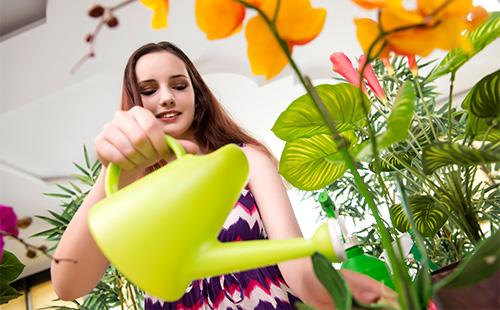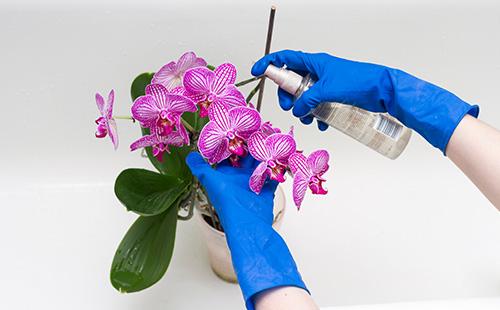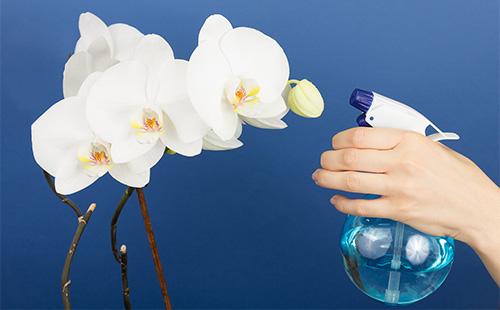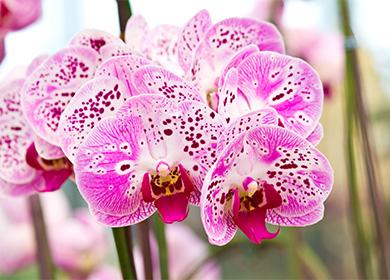The content of the article
The plant belongs to a large family of Orchidaceae. Interestingly, they account for almost a tenth of all known plants. Most of them grow in tropical climates.
Main characteristics
Most orchids are epiphytic plants. Epiphytes grow on trees, fixing roots behind their bark, but do not parasitize. Some species settle in the mountains on rocky slopes. The size is different - from dwarf species to tall two-meter plants.
The roots of epiphytic orchids perform several functions at once:
- fixation on the bark of trees;
- getting moisture and nutrients;
- participation in the processes of photosynthesis.
Flowers come in different colors, sizes and shapes. Inflorescences are mainly of two types - spike-like with a single arrangement of flowers or racemose with several flowers growing along the stem.
Flower selection
Only a healthy plant that is not infected with fungi and insects, grown in favorable conditions, adapts well. When buying, pay attention to the following points.
- Roots. Well-developed green or gray roots are an indicator of plant health. In an orchid in the stage of active growth, the tips of the roots turn bright green. Aerial roots are elastic. The softness and hollowness of the aerial roots indicates a poor condition of the orchid. The flower should hold tightly in the container, not to heel on one side.
- Leaves. Normally, the leaves are elastic, of a uniform green color. Symptoms of a diseased orchid are drooping, wrinkled leaves covered with a sticky or whitish coating. Dark color indicates a lack of light, reddish indicates an excess. Dots on the leaves indicate damage by pests. Accordion folded leaves - growth in low humidity.
- Flower stalk. Choose an orchid with a predominance of buds, rather than fully blooming flowers. The presence of spots, dots on flowers is an excuse to refrain from buying. Pay attention to the growth point - it must be elastic, solid.
Actions after the purchase
It is necessary to create favorable conditions for acclimatization, adaptation of the plant in a new place. The following guidelines are recommended.
- Quarantine. For two weeks, the orchid is placed separately from other flowers. All this time the plant is kept in moderate light, protected from direct sunlight.
- Top dressing. No fertilizer is applied during the first two weeks. The flower must independently adapt to new conditions.
- Watering. The amount of water is limited. Regularly check the condition of the leaves and stem. The drought period will not only help the plant adapt, but also identify possible pests. After two weeks, watering is gradually resumed, the orchid is rearranged in a more illuminated place. They accustom to light gradually.
Proper lighting
For the full development of orchids, the duration of daylight should be at least 12 hours. In winter or when kept in shaded areas, artificial lighting is used. In summer, you can do without additional lighting. For maintenance on the south side, place the pot away from the window. The need for lighting varies depending on the type of orchid. According to this parameter, there are three categories of colors listed in the table.
Table - Lighting rate for individual species of orchids
| Group | Title | Lighting requirements |
|---|---|---|
| 1 | - Wanda; - Cattleya; - dendrobium; - oncidium | - Allowed to grow on the windowsill; - east or west side; - fenced off from direct sun |
| 2 | - Miltonia; - odontoglossum; - cymbidium | - Allowed to be placed on dimly lit window sills; - diffused sunshine no more than 5 hours a day |
| 3 | - Paphiopedilum; - phalaenopsis | - It is not recommended to put on windows; - exclude sun exposure; - the lighting is bright but diffused |

Basic care
Before buying, you need to study the needs of the flower and evaluate whether you can create favorable conditions for growth. It is recommended to follow the basic rules of care.
- Temperature. The temperature of the content depends on the variety of orchids. Most of them feel well at 18-22 ° C during the day and 12-15 ° C at night. For all orchids, a daily temperature difference of about 5 ° C is required.
- Watering. Water as needed. They try not to waterlog the substrate. For irrigation use settled or boiled water. The use of hard water leads to the formation of salt deposits.
- Humidity. Prefer high humidity. Spraying is beneficial for orchids. Humidity is increased in various ways - set next to a bowl of water or special humidifiers. Cultivation in aquariums and florarium is practiced.
- Transfer. Transplantation is carried out no more than once every two to three years. Indications for transplantation - poor condition of the substrate, a small pot. During the formation of buds and flowering do not transplant.
- The soil. Take a breathable substrate from pine bark, sphagnum, coal. For beginners it is better to use a special store soil.
- Pot. Choose plastic clear pots. Through such walls, the roots are clearly visible, it is possible to constantly monitor their condition. Some species are grown without pots - in hanging planters or driftwood.
- Top dressing. Overfeeding is not necessary. Fertilizers are applied no more than once every two to three weeks. Use specialized tools. The Bona Forte complex, Pocon, is well suited. The accumulation of mineral salts is undesirable. Between dressings, the substrate is washed with running water in the shower. In the rest period they do not feed. Frequent top dressing is harmful. An overfed plant loses its resistance to disease.
Watering
Watering orchids has its own characteristics. As can be seen from the table, certain varieties need different moisture content of the substrate, the frequency of watering.
Table - Watering different types of orchids
| Title | Watering Recommendations |
|---|---|
| - Phalaenopsis; - miltonia; - Paphiopedilum; - cymbidium | - Stable humidity; - do not allow drying out; - avoid moisture stagnation |
| - Cattleya; - oncidium; - dendrobium; - odontoglossum | Watered after the soil is completely dry. |
Signs of lack of moisture
To determine the lack of moisture can be a number of signs. Pay attention to the following points.
- Pot weight. It is lighter than usual - the substrate is completely dry.
- Condensate. If the orchid is grown in a transparent container, the moisture content of the substrate is easily monitored by the presence of condensate. No condensation - the soil is dry.
- Root color. Wet roots turn green. With a lack of moisture, they become light.
Watering Techniques
There are several watering techniques. The choice of one of them depends on the variety of orchids. The table below shows watering options suitable for certain types of orchids.
Table - Irrigation techniques based on the variety of orchids
| Watering method | View name | Method Description |
|---|---|---|
| Immersion | - Paphiopedilum; - phalaenopsis; - dendrobium; - Wanda; - cumbria | - The pot is installed in the basin; - 2/3 bowl filled with water; - hold for 15 minutes and get it |
| Spraying | - Cattleya; - cymbidium; - miltonia | Leaves and roots are sprayed from a fine spray. |
| Watering can | - Wanda; - Paphiopedilum; - dendrobium; - cumbria; - phalaenopsis | - Pour water into a watering can; - pour a thin stream on a substrate; - repeat several times until completely saturated with moisture; - allow excess water to drain |
| Spraying leaves | Suitable for all types except miltonia. | Air is sprayed from a small atomizer around the top of the plant |
| Sprinkling | Suitable for all kinds | - Watered with warm water from the shower; - excess moisture is removed with a cotton pad |

Flowering stimulation
An orchid is bought for a beautiful bloom. Improper care inhibits the formation of peduncle and flower buds. Everything affects the flowering - the dormant period, care in the stage of bud formation and after the flowers wither.
Reasons for the lack of buds
An orchid does not bloom if it is too young or the living conditions are grossly violated. The main reasons for the lack of flowering are the following.
- Excess fertilizer. Small intervals between dressings, a high concentration of nitrogen stimulate active growth, but inhibit flowering.
- Excess moisture. The substrate between waterings is dried. Excess moisture adversely affects flowering and roots.
- The absence of daily temperature differences. Under natural conditions, the orchid gets used to variable temperatures. When kept in stable temperature conditions, flowering does not occur or is sparse.
Ways to “spur” a flower
You can accelerate flowering if you create a stressful situation for the flower. That is, for several weeks to limit watering, top dressing, keep in a cool room.Under stressful conditions, the plant directs all forces to flowering - it throws out a flower stalk. As soon as this happens, gradually return to the usual care regimen.
Another way to stimulate flowering is to water 35-38 ° C with warm water. A small amount of potassium or phosphorus fertilizer is added to the water. Transplanting with a change of soil also sometimes stimulates flowering.
Measures after the wilting buds
You don’t need to immediately crop the arrow - buds or children can re-form on it. Trimming can only be done if the peduncle is completely dry. A trait - to a healthy lower kidney.
For the next flowering orchid need to recover. Watering is reduced, feeding is temporarily stopped. The flower is rearranged in a cooler, well-lit place. After the formation of a new flower stalk, they return to the usual regime of care.
Breeding methods
Propagation is easiest vegetatively. Different methods are applied depending on the variety.
- Cuttings. Cuttings are suitable for vanda, phalaenopsis, aeridis, ascocentrum, angrekum. All of them are monopodial orchids - one growth point, pseudobulbs are absent. As cuttings, segments of a peduncle or lateral shoot are used. Cut the stalk 15 cm long. Slices sprinkled with coal powder. Planted under the film in a horizontal position. Signs of growth appear after about a month.
- Kids. Suitable for phalaenopsis and dendrobium. Children are formed only in certain conditions - with increased humidity, in heat, after top dressing with nitrogen. After the formation of roots, the baby is carefully separated and planted under a film shelter.
- Seeds. The method is used extremely rarely even by experienced flower growers. For germination of seeds requires a special nutrient medium and complete sterility. This method is more suitable for laboratories.
- Division. It is used for orchids of the sympodial type. Known varieties are Cattleya, Cymbidium, Miltonia, Cherish. The plant is extracted, the roots are freed from the substrate. The bush is divided - two pseudobulbs are left on each dividend. Slices are treated with charcoal powder, delenki are planted in individual pots.
Common diseases
Violation of the regimen of care, the use of an infected substrate, an excess of fertilizers lead to the development of diseases. How to determine the disease, how to deal with it - see the table.
Table - Orchid diseases and treatment methods
| Disease | Description | Treatment |
|---|---|---|
| Bacterial spotting | - Yellow leaves; - blackening of leaves; - the appearance of wet ulcers | - Removal of affected parts; - treatment of sections with iodine; - quarantine |
| Anthracnose | - Brown spots with clear borders; - blackening of spots; - appearance of plaque | - Removal of damaged areas; - treatment with ash, coal powder; - spraying with means "Ridomil", "Mikosan" |
| Powdery mildew | - Whitish powdery coating; - drying of the affected parts | - Spraying with colloidal sulfur; - spraying with means "Skor", "Topsin-M" |
| Rust | - Light spots on the back of the leaves; - the formation of red pads | - Trimming of the affected parts; - processing of slices with coal powder; - spraying "Ridomil", "Mikosan" |
| Soot fungus | - black coating; - plant death | Repeated spraying with "Mikosan", "Topsin-M" |
| Root rot | - Rotting of roots and leaves; - change their color to brown; - softening of roots and leaves | Treatment with a 0.2% solution of fungicide "Fundazole" |
| Gray rot | Fluffy Gray Plaque | - Repeated spraying with any fungicide; - reduction of watering; - decrease in air humidity; - regular airing |
| Fusarium rot | - Yellowness of leaves; - twisting the edges of the leaves; - rotting of the main shoot | Daily treatment with 0.2% Fundazole solution for 10 days |
| Brown bacterial rot | Watery spots on young leaves | - Trimming of the affected parts; - processing of slices with coal powder; - watering the substrate with Previkur 0.2% concentration |

Typical pests
Pests can attack even a perfectly healthy plant. They enter the apartment from the street, enter the house with new plants infected with the substrate. It is important to notice them in time. The table shows data on the most common pests and measures to control them.
Table - Orchid pests and how to deal with them
| Pest | Signs | Wrestling |
|---|---|---|
| Shield | - Brown tubercles on the leaves; - the appearance of sticky plaque | - Mechanical removal of insects; - rubbing the leaves with alcohol; - spraying with preparations "Fitoverm", "Actellik" |
| Whitefly | - Little white butterflies; - laying of larvae on the underside of leaves | - Mechanical extermination of insects; - funds from flying insects; - treatment with soapy water; - treatment with the drug "Actellik" |
| Mealy and root mealybug | - The appearance of a white cotton coating; - yellowing and falling of leaves | - Removing damaged parts of the plant; - soil treatment with Fitoverm; - transplant with a complete replacement of the soil; - root treatment with fungicide |
| Spider mite | - The appearance of a thin cobweb; - yellowing, drying of the plant | - Increase in humidity; - spraying with drugs "Actellik", "Neoron" |
| Aphid | - Colonies of green insects; - leaf deformation; - sticky coating | - Spraying with insecticides; - soapy water treatment |
| Thrips | - Black dots on the petals; - spots on the leaves; - constrictions on the roots | - Bathing in a warm shower; - removal of damaged tissues; - spraying with Fitoverm |
| Nematodes | - mortification of tissues; - rot; - stunting | - Quarantine; - hot shower; - transplantation into a sterile substrate |
Beginners are encouraged to start their first experiments on growing orchids with unpretentious species. For example, from phalaenopsis.

